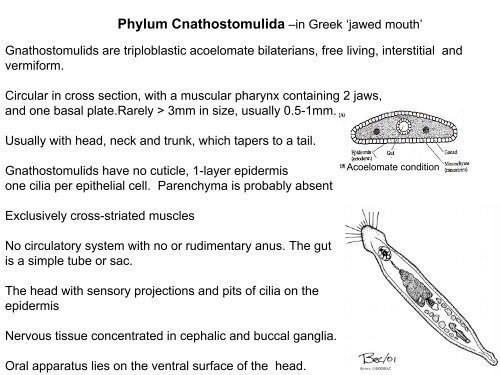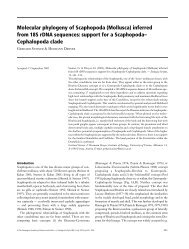Gnathostomulida lecture.pdf
Gnathostomulida lecture.pdf
Gnathostomulida lecture.pdf
You also want an ePaper? Increase the reach of your titles
YUMPU automatically turns print PDFs into web optimized ePapers that Google loves.
Gnathostomulids are triploblastic acoelomate bilaterians, free living, interstitial and<br />
vermiform.<br />
Circular in cross section, with a muscular pharynx containing 2 jaws,<br />
and one basal plate.Rarely > 3mm in size, usually 0.5-1mm.<br />
Usually with head, neck and trunk, which tapers to a tail.<br />
Gnathostomulids have no cuticle, 1-layer epidermis<br />
one cilia per epithelial cell. Parenchyma is probably absent<br />
Exclusively cross-striated muscles<br />
Phylum Cnathostomulida –in Greek ‘jawed mouth’<br />
No circulatory system with no or rudimentary anus. The gut<br />
is a simple tube or sac.<br />
The head with sensory projections and pits of cilia on the<br />
epidermis<br />
Nervous tissue concentrated in cephalic and buccal ganglia.<br />
Oral apparatus lies on the ventral surface of the head.<br />
Acoelomate condition
Austrognatharia kirsteueri<br />
Order Bursovaginoidea<br />
Tail is contractile<br />
Haplognathia simplex<br />
Order Filospermoidea
Gnathostomula paradoxa<br />
Haplognathia<br />
Gnathostomulids<br />
rostrum<br />
cilia<br />
Rostrum with simple sensory cilia<br />
(Filospermoidea) or 4-5 pairs of<br />
compound sensory cilia (Bursovaginoidea)<br />
Pharyngeal jaw<br />
Rastrognathia macrostoma
Mouth ventral behind rostrum<br />
Bilaterally symmetric, muscular pharyngeal bulb situated posteriorly in<br />
ectodermally-derived buccal cavity<br />
Hard parts secreted in situ in ectodermal folds; no growth zone
Gnathostomula armata<br />
Ventral<br />
Gnathostomulid Jaws<br />
2 toothed jaws assoc with pharyngeal bulb<br />
Single basal plate inside lower lip, toothed<br />
or not. Various pharyngeal glands present
3 gnathostomulids and their jaws
Reproduction<br />
Most are hermaphrodites, but<br />
some are monoecious.<br />
Males with 1-2 testes, females<br />
with a single large ovary<br />
Fertilization occurs internally<br />
with the production of a single<br />
large egg.<br />
The egg later escapes from the<br />
body by breaking directly<br />
through the body wall.<br />
Cleavage of the egg is spiral,<br />
and the development to<br />
adulthood is direct.
Distribution<br />
Worldwide in marine gravels to muds (fine sands optimally); intertidal to several m<br />
Interstitial animals. All movement is achieved through ciliary gliding, swimming and<br />
contortion of the body.<br />
Highest densities in sulfide rich, anoxic marine sediments<br />
Encrusted bacteria and fungi are scraped up by the basal plate, and chopped by the<br />
jaws before passing into the gut.
Nervous system<br />
Nervous system intraepidermal, brain in rostrum, six symmetrically disposed<br />
longitudinal nerve cords, 2 additional nerve cords from brain to ganglion associated<br />
with the pharyngeal bulb<br />
1. Sensory cells, compound bristles all monociliated except perhaps for a pair of<br />
spiral-ciliary organs flanking the mouth<br />
2. Ciliated pits of unknown function often present on rostrum<br />
3. No eyes, statocysts<br />
Excretory system<br />
Protonephridia are isolated solenocytes similar to epidermal cells which join a canal<br />
cell opening on the body surface<br />
Muscular system<br />
Body wall musculature in outer circular, and 6 inner longitudinal, symmetrically<br />
disposed bundles of fibers (associated with 6 longitudinal nerve cords)
Taxonomy<br />
<strong>Gnathostomulida</strong> were initially described as aberrant turbellarians (Ax 1956)<br />
Made a distinct phylum by Rupert Riedl (1969)<br />
Two Orders<br />
Order Filospermoidea - long pre-oral rostrum, males without penis, sperm<br />
filiform females without vagina<br />
ca. 20 spp.<br />
Order Bursovaginoidea – Body length/width ratio not as high as the<br />
filospermoids. Males with penis, sperm not filiform, females with bursa and<br />
most times vagina<br />
Suborder Scleroperalia<br />
ca. 30 spp.<br />
Suborder Conophoralia<br />
ca. 10 spp.
The phylogenetic position of Gnathostomulids is not resolved<br />
They share a number of features being shared with the turbellarian flatworms, with<br />
whom they were formerly included.<br />
But the presence of monociliate cells, and a cross-striated musculature is more<br />
indicative of Cnidarian or perhaps Gastrotrich affiliations.<br />
Gnathostomulids could be the missing link between the Cnidarians and the<br />
Turbellarians.








